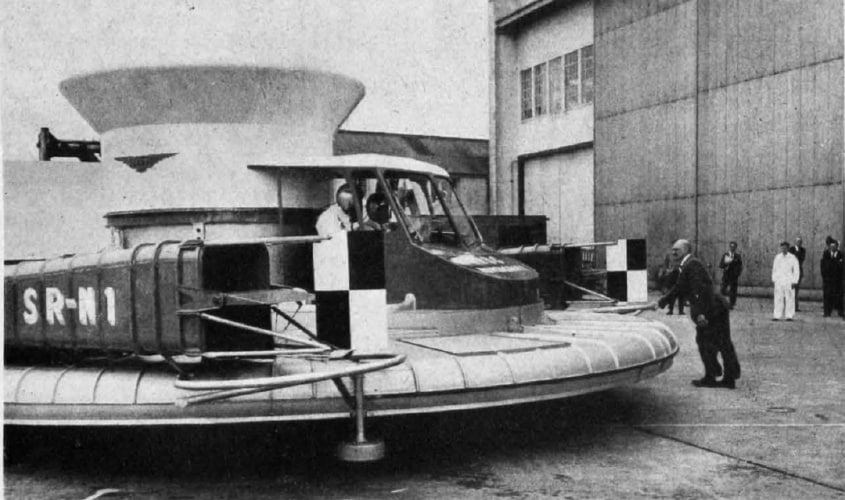
The culmination of six years of work, during which its inventor, Christopher Cockerell, was forced to sell his personal possessions to fund the project, the SR-N1 hovercraft research vehicle was built by Saunders-Roe on the Isle of Wight and ‘flew’ for the first time on the 11 June 1959.
Privileged to witness this landmark event in maritime history, The Engineer wrote: ‘The principle of operation is closely related to that of the jet flap, a pressure difference being sustained by the change in momentum of the jet sheet: the product of “cushion” pressure and hovering height has proved to be, as simple theory predicts, the change of momentum in deflecting the jet sheet into the horizontal plane.’
In the picture, Cockerell is shown pushing the machine while it floats on its cushion of air. The article continued: ‘In the foreground can be seen one of the four propelling nozzles with the control vanes that allow a transverse or vertical component of thrust to be developed. The Yaw vanes at the rear nozzles are extended upward to give directional stability and improved yaw when flying forward.’
A couple of months later, on 25 July, the prototype craft, which was capable of carrying four men at a speed of 28mph (45km/h), made a successful crossing of the channel.
In an earlier article on the topic, published on May 1st 1959, The Engineer outlined proposals from Saunders-Roe for the construction of a succession of manned vehicles, “the next step would be a 30-ton craft to carry 100 passengers over sheltered waters, powered by a Rolls-Royce “ Dart,” and the subsequent, and probably near optimum, model would be a 400-ton ferry for up to 1200 passengers and eighty cars, which, with seven Rolls-Royce “ Tyne “ engines, would attain heights of 6ft and be able to operate regularly over the English Channel.”
Commenting on the potential market for the technology the article continued: “Applications foreseen for these machines are in the smaller sizes, ferrying where high speed is important, as between the Great Lakes cities in North America or to offshore oil rigs, and, for large machines, short sea journeys where traffic is heavy….as in the English Channel.”
“It is predicted that the high cruising speeds will result not only in a popular vehicle, but also in specific costs somewhat lower than those of existing displacement and planing craft,” concluded the article
In the UK, commercial cross-channel hovercraft operations ceased in 2000, although a service still operates across the Solent from Southsea to Ryde on the Isle of Wight. The vehicles are also widely used by the military.











McMurtry Spéirling defies gravity using fan downforce
Ground effect fans were banned from competitive motorsport from the end of the 1978 season following the introduction of Gordon Murray's Brabham...